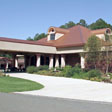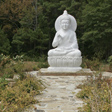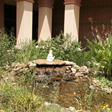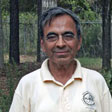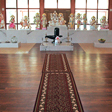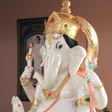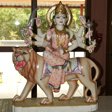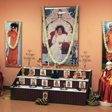Other Shreveport Articles
Cultural Preservation: Keeping the Flame Burning for Future Generations
Seasons and Cycles — Festivals and Rituals Mark Life's Rhythms
Of Hand and Heart: Handwork Connects Family and Community

Shreveport's Indian Community: Three Organizations, Shared Visions, Treasured Cultural Traditions
By Laura Marcus Green
A Labor of Love: Sadhu Vaswani Hindu Cultural Center and Hindu Temple
Driving through the wrought-iron gates of the Sadhu Vaswani Hindu Cultural Center and Hindu Temple, one enters a tranquil oasis. Sadhu Vaswani founders Drs. Manohar and Bharti Manchandia commissioned the hand-hewn gate from a local craftsman. This attention to beauty and detail resounds throughout the center and temple, from its carefully tended gardens and grounds to its vast, open gathering hall.
The Manchandias were among the earliest Indian families to settle in the Shreveport area. In 1981, after their medical training first in India and then in Michigan, they arrived in Shreveport, where they have both worked as pediatricians ever since. As Shreveport-Bossier City's Indian community grew, the Manchandias saw the need for a place where people could gather for Hindu cultural events and worship. The dream was long in the making, as building permits and funding fell into place. The cultural center and temple opened in 2006. The Manchandias put up 75% of the funds, with Shreveport-Bossier City's Indian community contributing the remaining 25%.
In designing Sadhu Vaswani, Dr. Bharti Manchandia worked closely with an architect, which is evident in the building's magnificence. The center's exterior is contemporary, harmonizing with the woods and landscaping that surround it. A large statue of Buddha sits serenely at one end of the grounds, radiant white against a deep green tree line. At the other end, by the entry gate, a waterfall garden ripples, beckoning visitors to take in the quiet setting of this sacred space.
Across the drive, a plaque commemorates a visit in 1996 from J.P. Vaswani, the Chinmaya Mission leader from India and nephew of Sadhu Vaswani, for whom the cultural center/temple is named. T. L. Vaswani (1879-1966) wrote many inspirational texts during India's struggle for freedom, and throughout his lifetime authored voluminous spiritual texts and poems. Sadhu is an Indian title for one who is diligent and accomplished in spiritual discipline. Sadhu Vaswani, as he was affectionately known, founded the Brotherhood Association in 1929 in Hyderabad, Sindh, India. After his passing, the association was renamed in honor of its founder. Today J.P. Vaswani leads the organization, which is engaged in various philanthropic activities in such fields as education, health care, social services, animal rights, hunger, and spiritual inspiration2. During his visit to Shreveport, J.P. Vaswani blessed the grounds where the future cultural center and temple would be built.
Today, Sadhu Vaswani Hindu Cultural Center and Hindu Temple sits on 107 acres of land. The spacious gathering hall (10,000 square feet) is the site of the weekly service, Bhajans and Family Mantras, special observances, and yoga classes that are hosted by the temple several days a week. With its expansive wooden floor and light coming in from windows on three sides and from a mezzanine above, the hall is light and airy. Along one side of the main hall is an altar on which elaborately hand carved and painted marble statues of Hindu deities are arranged for worship. Dr. Manohar Manchandia commissioned these pieces in Jaipur and imported them from India.
Each Sunday, regular services are preceded first by a Surya Namaskar yoga session taught by an Indian yoga master. Following the yoga session are Sai Baba Bhajans, or devotional songs for Sai Baba, held in a separate room in an educational annex adjacent to the main building. Sai Baba was an Indian guru who is venerated by some members of the congregation. After Sai Baba Bhajans, the entire congregation takes part in services in the main gathering hall. Following the morning's services, the congregation shares a vegetarian meal prepared by the Manchandias.
During services, people sit facing east towards the altar. Representing the pantheon of Hindu deities, the statues provide the focal point for worship, as the calendar cycles through particular observances during the year. Sharing the sacred space with the altar are hallmarks of the Sadhu Vaswani Hindu Cultural Center and Hindu Temple's spiritual emphasis, which is affiliated the Chinmaya Mission, a branch of Hinduism that subscribes to the Vedantic philosophy. According to the Chinmaya Mission's website:
The Chinmaya Mission was established in India in 1953 by devotees of the world-renowned Vedanta teacher, His Holiness Swami Chinmayananda. Under his guidance, devotees formed the nucleus of a spiritual renaissance movement that now encompasses a wide range of spiritual, educational, and charitable activities in India and outside its borders. "To give maximum happiness to the maximum number for the maximum time" is the tenet that drives Mission workers to uplift humanity beyond selfish and sectarian attitudes and activities. His Holiness Swami Chinmayananda emphasized the balance of head and heart, pointing out selfless work, study, and meditation as the cornerstones of spiritual practice. Chinmaya Mission centers worldwide serve the spiritual and cultural needs of local communities.3
The closest Chinmaya Mission center to Shreveport is in Houston, Texas. Sadhu Vaswani has sent ten parents from its congregation to the center in Houston for training to become Sunday school teachers. One couple who attends Sadhu Vaswani did a year's apprenticeship at the Chinmaya Mission center in Piercy, California.
Dr. Manchandia explains some of the core beliefs that inform Hinduism. Hindus believe in one god, which keeps the mind focused. However, the Hindu pantheon also consists of different deities representing particular qualities, each with its own story or lesson. Hinduism also embraces the belief that the gene of divinity is in everyone but that it is up to each individual whether he or she realizes this potential through his or her thoughts and actions.
In 2007, the completion of an adjacent educational annex expanded Sadhu Vaswani's capacity for educational and other cultural activities. The new building includes classroom space for youth and adult education, a worship room for Sai Baba, and a room for specialized yoga instruction and practice. Each year, the Sadhu Vaswani Hindu Cultural Center and Hindu Temple sponsors a Balavihar or Sunday school session encompassing classes intended to
"teach our children our religion, culture and about being good citizens of this country and this world . . . The purpose of Balavihar is to make our children proud of their heritage and roots. All of this is done with examples and information from the Hindu scriptures. We also teach them the true meaning of various customs and festivals in India.4
Established in 2004, the Balavihar offers classes for K-12 students. The cultural center-temple also sponsors a youth heritage camp each spring. The community's emphasis on their children's cultural and spiritual training is evident at Sadhu Vaswani's weekly Bhajans and Family Mantras. A segment of the service is devoted to youth, who, modeling their elders, take turns leading the congregation in bhajans, or devotional songs.
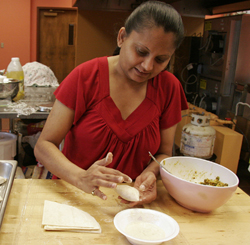
When designing the temple and cultural center, the Manchandias were mindful of the building's role as a gathering place. Adjacent to the hall is a state-of-the-art kitchen where the couple cooks vegetarian meals for congregants to share following weekly services and special occasions. The spacious kitchen offers ample storage for an impressive array of cooking tools, and abundant work surfaces. French doors at either side of the room allow light to spill into the kitchen, illuminating walls painted in cheerful tones. Just outside the back door Dr. Bharti Manchandia maintains a kitchen garden. She uses sustainable practices such as recycling, composting, and mulching, striving to throw nothing away. Subscribing to a philosophy of giving back to the earth, the Manchandias built the cultural center and temple as a green facility. Beyond the garden, an arbor provides a shaded space for the congregation to enjoy meals together. An indoor serving and dining area is available during cooler or inclement weather.
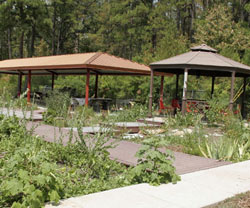
Every Sunday the Manchandias arrive at the temple at 5:30 am to prepare the weekly meal in time to participate in the yoga session preceding services. Vegetarianism is a component of Chinmaya Mission practice. Neither meat nor smoking is allowed on Sadhu Vaswani premises. Dr. Manohar Manchandia quotes Sadhu Vaswani himself, "If you can't give life to anybody, you can't take life from anybody. Hands are to help, not hurt. To be happy, help others. Happiness is within you." Dr. Manchandia observes that "If you cook with devotion, the food comes out good." Congregants who stay for lunch following services are treated to homemade yogurt, freshly steamed rice, delicately seasoned savory soups and stews, and desserts like rice pudding enriched with almond meal. Congregants pitch in to help clean the dining area and kitchen following the meal. Like so many aspects of the cultural center-temple, these weekly meals, prepared with devotion, coalesce Dr. Manchandia's cultural and spiritual practice with his avocation as a medical professional, all motivated with people's wellbeing at heart.
Community service is a tenet of Chinmaya Mission. Indeed, it was the concept of service that first inspired Dr. Manohar Manchandia to choose the United States as his home in the 1970s. Considering his options around the globe at that time, he felt that the U.S. was home a duty-based society. Dr. Manchandia's sense of duty to his chosen country led him to serve in the U.S. Air Force Reserve for 21 years.
The Manchandias come to the cultural center-temple most evenings after dinner and a full day's work. Dr. Manohar Manchandia also spends Saturday mornings at Sadhu Vaswani, where he participates in a yoga class and is on hand should anyone need to come to the center-temple. Regarding this labor of love, Dr. Manohar Manchandia says, "The work is a vacation for me." Indeed the quiet beauty of the temple-cultural center and its grounds make them a haven. When asked why he has devoted so much of his time and resources to Sadhu Vaswani, Dr. Manchandia responds that he wants to help the community, reflecting that, "My belief system is to help as many people as you can. I had the resources and I wanted to utilize them properly. When our children were little, they didn't learn their culture. Now, other children can learn."
Notes
1. From the Indian Association of Shreveport-Bossier website, http://ias-b.org.
2. http://en.wikipedia.org/wiki/Sadhu_Vaswani_Mission.
3. www.chinmayamission.org
4. From the Sadhu Vaswani Hindu Cultural Center and Hindu Temple, www.svhinduculturalcenter.com


